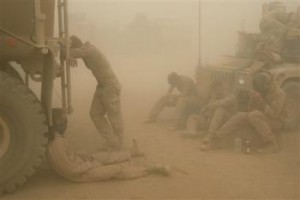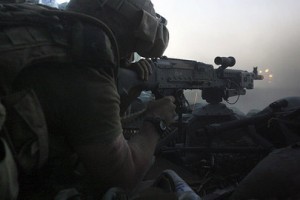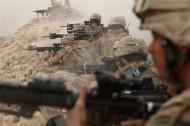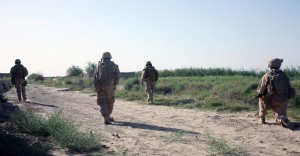Army (Exoskeleton) or Marines (V-22): Who Wins?
BY Herschel SmithThe Captain’s Journal proudly stirs the pot and agitates yet another interservice kerfuffle over money – or rather, how it is spent.
We have a category for the V-22 Osprey troop transport aircraft, and long ago strongly suspected that it would be an outstanding success in its debut deployment in Iraq. It has been, but a recent analysis at the National Journal entitled Future Corps (an analysis which itself it worth protracted study time) points to larger problems with the aging Marine air fleet and the role of the V-22.
At the end of April, a squadron of the Marine Corps’s new V-22 Ospreys returned from the aircraft’s first overseas deployment, a seven-month tour in Iraq. The Corps trotted out pilots and ground crews to talk up the $67 million machine, a hybrid of helicopter and propeller plane whose revolutionary tilt-rotor technology took 25 years to develop and claimed 30 lives in crashes along the way.
Largely overlooked in the coverage and the controversy over the V-22 itself, however, is the fact that the aircraft was never meant to stand, or to fight, alone. The Osprey is simply the single most expensive element of an ambitious plan to re-equip the Marine Corps to execute a new kind of sea-based blitzkrieg.
Marine officers began to develop the concept, often called “operational maneuver from the sea,” a quarter-century ago at the height of the Cold War, when the rise of advanced anti-ship missiles was already threatening any fleet massed for a conventional, large-scale landing in the style of Iwo Jima. Today, the V-22 and key technologies like it are finally entering service in a world radically different from the one in which they were conceived–a world in which some of the weapons that the Soviets developed 25 years ago are now in the hands of guerrillas and terrorists in developing countries.
For the Marine Corps, looking forward to a large-scale pullback from Iraq even as it takes on a new mission in Afghanistan, the vision is not merely about new technology. It is about returning to the Corps’s historic role as a shipborne rapid-reaction force after five years of grueling ground warfare alongside the Army.
“We’re not a second land army,” said Maj. Gen. Thomas Benes, the director of expeditionary warfare on the Chief of Naval Operations’ staff. “We can always be used to complement the [Army’s] mission on the ground, and we don’t shy away from a fight,” he emphasized. “But our real traditional role of being a naval force is what we want to get back to.”
To carry out this old role in a new way with new equipment, however, will be expensive. Like the Army, the Marine Corps has worn out in Iraq much of its inventory of weapons, aircraft, and vehicles, most of which were bought during the Reagan-era buildup. Unlike the Army, which has packaged its main modernization programs into a single, high-profile, hard-to-explain and heavily criticized Future Combat System, Marine modernization is scattered across a half-dozen programs, some small enough to fly below most media and congressional radars. What’s more, because the future Marine force will be carried into battle on Navy ships built with Navy money, about a sixth of the total cost to realize the Corps’s vision will not be counted in the Corps’s budget …
“There were a lot of arguments for and against the V-22,” said Robert Work, a retired Marine colonel who is an analyst at the Center for Strategic and Budgetary Assessments. “Five years ago, I was not a fan. But the bottom line is, now there really is no other option. The war has essentially worn out the Marine Corps helicopter fleet. The V-22 is the answer we’re going to make work” …
The Osprey’s speed and range are arguably overkill for Iraq, where most missions are short-range hops in and out of the many U.S. bases. Its aptitude for altitude, however, has already proven useful: Insurgents have shot down conventional U.S. helicopters with machine guns, but the V-22 can climb to 13,000 feet, too high to hit with small-arms fire. Insurgents have occasionally used shoulder-fired anti-aircraft missiles, which can reach higher targets, but flying higher than conventional helicopters gives Osprey pilots more reaction time to drop flares and evade.
A rumored deployment of V-22s to Afghanistan, where U.S. troops are spread thin over vast distances and at high altitudes, should be a better test of the V-22’s performance. But where the Osprey really shines is at even longer ranges. When the marines first deployed from their ships to Afghanistan in 2001, for example, they had to move in laborious stages from the Indian Ocean with the help of landing areas in Pakistan. With the V-22, the same force could have flown over Pakistani territory and hit the Taliban stronghold of Kandahar in two hours.
And for the Army future combat system? It includes things like the exoskeleton.

A complex interconnected array of computers, motors, servos, electronic feedback loops, load bearing members and batteries which deplete far too quickly, the exoskeleton is supposed to assist the Soldier in the field by amplifying human movements.
The Marines say “uh, huh.” Batteries which wear out, a system that is heavy and bulky and uncomfortable, weeks or even months of training required to use it, the inability to perform mounted patrols, untold and yet to be determined equipment interference problems – where is the body armor, hydration system, backpack, weapon and ammunition going to go – and the likelihood that upon (the highly probable) malfunction it will be jettisoned in the field, and the Marines will probably respond: “The V-22 flies. You might not like what we spent to get it there, but at least we didn’t throw money after that monstrosity. Are you proud of yourselves?”
Why not spend the money on technology for lighter ballistic (SAPI) plates to decrease battlespace weight for the U.S. warrior? We have previously said that this needs to be done. Is anyone listening?








